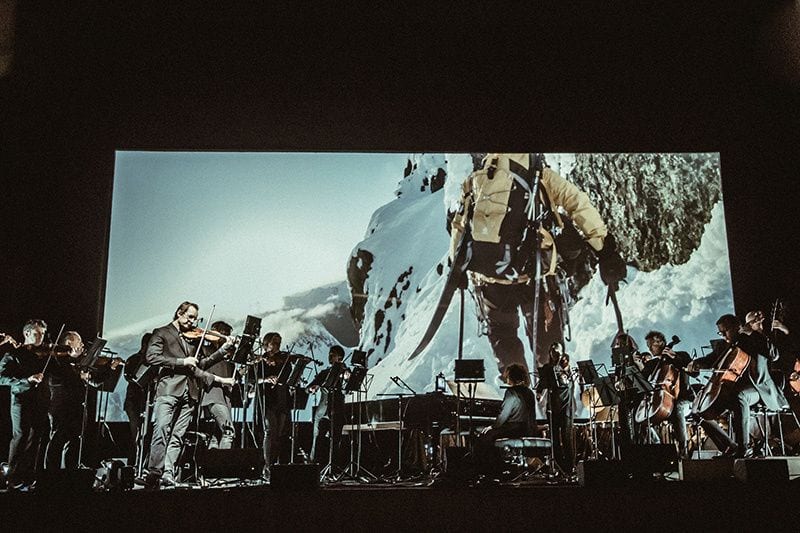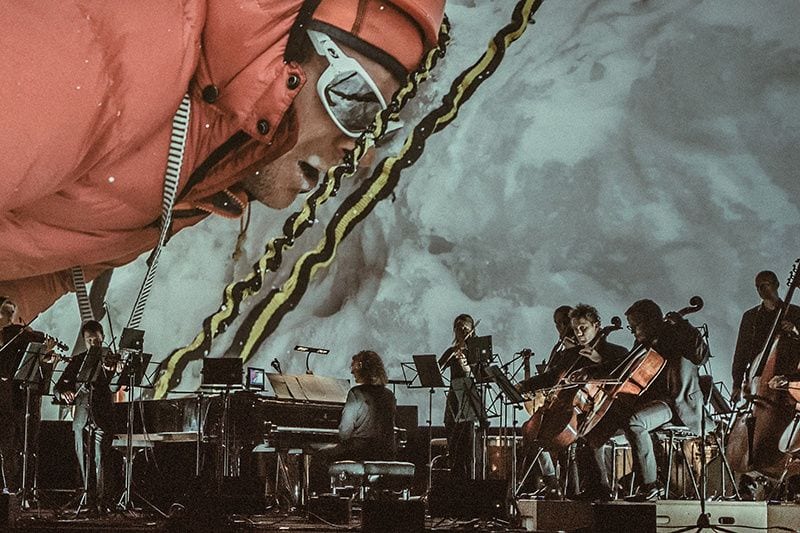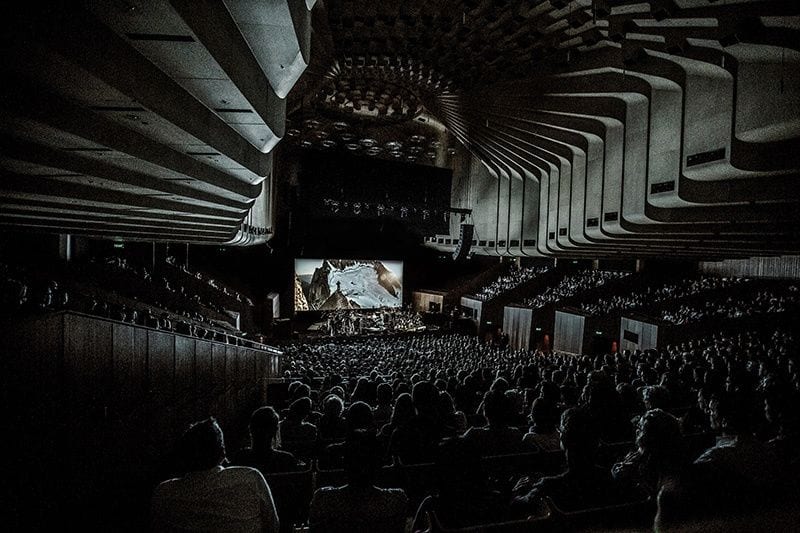
Mountain (2017) is a musical collaboration between the Australian Chamber Orchestra (ACO) and filmmaker Jennifer Peedom. Exploring the alluring force mountains hold over the imagination of humankind, Willem Dafoe narrates the words written by Peedom and British writer Robert Macfarlane.
The ACO and their Artistic Director, Richard Tognetti, appeared at The Barbican, London in October of this year for a live performance of Mountain, ahead of their scheduled return to the venue in 2019 and 2020. Tognetti was recipient of the 2018 Australian Academy Cinema Television Arts (AACTA) award for Original Score for the documentary. In addition to Mountain, he also co-composed the film score for Peter Weir’s Master and Commander: The Far Side of the World (2003), and additional music for Simon Baker’s Breath (2017).
In conversation with PopMatters, Tognetti discusses creating a collaborative relationship with Peedom, and how their expectations and intentions for the project shaped it through compromise. He also reflects on the impact of the Second Viennese School on classical music, the reliance on music in cinema, and not impairing the brain’s ability to astro-travel through multi-sensory experiences.
Why music as a means of creative expression? Was there an inspirational or defining moment?
I started violin lessons when I was five, and I remember coming back from my first lesson set on that path already, immediately thinking: That’s what I want to do!
I often speak to filmmakers about the process being a constant learning curve, and whether each film has the capacity to teach them something individual, and specific to that experience. You have played and conducted the works of some of the great composers, and worked with highly respected orchestras. Does each experience teach you something new that expands your understanding?
Oh yeah, absolutely, and making something like Mountain is a massive learning experience. We’d made a few films before, bespoke films. One we did at The Barbican last year called Reef (2013), which was on surfing. We learned a lot about how to synergise the music with film, but that’s on a massive learning scale.
Every time you stand on stage and perform, you hope you are going to come away with some lessons learned, absolutely. And you know, nothing really takes the place of walking onto those boards and standing in front of an audience for learning.
What was the genesis of the Mountain project?
After the success of Reef, so many people were saying: “Well, what are you going to do next?” Funnily enough the chairman of our board said that he thought we should investigate mountains. I’m a mountain person as well as being a sea person, and so I thought this was not the best idea because I think skiing movies are pretty boring, and I’m not into snowboarding or rock climbing. And then we had this opportunity to collaborate with Banff in Canada, a creative retreat, which is in the mountains. We went there and we started collaborating with them, but then it was unnecessary to pursue that collaboration, and we were a project looking for a director.
One of our cellists suggested we collaborate with Jen Peedom, and so I met her, and we hit it off. Sherpa (2015) hadn’t come out, it was just about to, and I watched her film called Solo (2008) about a crazy Kayaker who traversed the Tasman Sea. It was terrific filmmaking and so we ended up kickstarting the motorbike, and went on this amazing journey.
In film, the concept of collaboration is liable to an oversimplification that disregards the audience, favouring the collaboration between the various persons behind and in front of the camera. When you came to collaborate with Jennifer, how did you find a dialogue of communication that allowed you to work together, bearing in mind that not everyone can successfully collaborate?
Absolutely not! In the state of play with film music these days, so much film music is simply the same and so we had to set down certain rules. We had to establish a framework that gave me musical freedom, but served the film, and she was the director, no arguing with that. But the thing about this project is that we commissioned her to make a film, and so it was driven by the music first and foremost, which is an interesting way.
I know this sounds hubristic, but Bernard Herrmann didn’t commission Hitchcock to write Psycho (1960), so this was an interesting genesis. We also envisaged that it was just going to be like how we presented it at The Barbican; we thought that was how it was going to be made, that we would always be playing this film live with the orchestra there. But Jen was insistent that we also make the film as a stand alone cinema experience.
As it turned out the film isn’t that much different. We have different placements of dialogue and so forth in the cinema version, but that was reliant on a lot of letting things go, and may the best idea win. It’s not just about the ego of the director, it’s about the project and to not forget the genesis of the project in the raison d’etre. So that means we really had to collaborate and I wasn’t just a composer and musician for hire.
And you talk about the collaboration with audiences… Yeah, we have this rather dark period in our classical music history. It’s called the Second Viennese School, which went all the way through until the death of the uber serious French composer Pierre Boulez, where for the audience, it was too bad if they don’t understand it, it’s their problem; this is for the art, whatever that means. Well, who’s listening to the art?
Now things have gone almost the opposite with social humanities; that contextualisation of art is so important. So you just can’t say Picasso is a great artist, you have to look at him in context of whether he was a misogynist and a wife beater. And so it was a dark path, but some great music came out of it in which the audience was totally irrelevant. It was almost like a scientist who isn’t thinking of his or her public, who is just dealing with theories to work out whether what he or she is pre-supposing is correct. Music was like this and my generation started questioning the validity of it, and withthis current generation, there are people who are just starting out who I think don’t question the necessity to collaborate with an audience.
You are absolutely right, you are making it for people to view. There’s a dilemma if you are just thinking of the audience because you’re not thinking of the audience as you are making it in the actual laboratory. But then when you start viewing it, you close the bonnet of the car, get in and it’s about how it feels on the road.
It’s interesting because when we got Willem Dafoe and we put the whole structure up, I realised that we had created a much more commercially viable product than our previous films, which were just made in the laboratory, and we hoped that people would like them. As you’ve probably read, this is now the most successful Australian documentary, and we had not even the vaguest desire to create a successful one. We were just creating an interesting art documentary along the lines of Werner Herzog, but which we would play music to.

Is it not possible to intentionally create something we’d term a masterpiece, rather it just somehow…
You can’t think about that. You hope that it’s going to resonate and that’s the best that you can do. It might only resonate with a few people, and often the things that you do that only resonate with a few, you personally believe are much better than, say, something that resonates with a lot more people.
I recall the sentiment that to explain why you love a piece of music undermines the feeling because it cannot be expressed through words.
Well as they say, talking about music is like dancing about architecture. I can talk to you of why I think certain things work in the context of the synergy between the music and the film, but to talk about why a particular piece of music works for some people, and by implication not for others, is impossible to do.
The interplay between image and sound is an interesting dynamic because without the sound, or with a different sound even, the meaning of the image changes entirely, and so meaning of the film changes.
Well look, I’d like to say two contradictory things here. I’d like to propose that a lot of directors totally overestimate the importance of music, and that you could have no music, or a different type of music, and the effect will be pretty much the same. Now that isn’t to mean that without Bernard Herrmann, the shower scene in Psycho is going to be equally as good. I’m not talking about those marquee moments in film: Star Wars (1977-), whether you like it or not, or the theme in Close Encounters (1977), or certainly the use of the Arvo Pärt in There Will Be Blood (2007), and then especially the Brahms Violin Concerto Third Movement at the end, and certain bits of Jonny Greenwood’s music. But for the most part, where directors are talking about: Well, this particular scene and you can see the lady’s hand up here like this, and it needs a certain orange moment here. It’s baloney, you could just have anything; I’m talking about that kind of filler music. Just get rid of the damn music, you don’t need music if the drama is so good.
But then on the other hand, what I was proposing — and I hope it works — is we’ve got this space in our brain, and it’s pretty much a void. Music then fills it up and creates this ability for us to astro travel, and when you combine it with a multi-sensory — well everything is a multi-sensory experience — but when you activate a more conscious multi-sensory experience as you do with film, music and dialogue, and also being amongst other human beings in a concert hall, then you’ve got to be really responsible.
You started off in your second question asking about what you learn, and what I learned from making these films is that if you have sensory overload, you nullify that part of the brains ability to astro-travel. And so what we found is that if there’s a lot going on on the screen, and a lot going on with the music and they are competing, the brain just starts shutting down. You have over amped that part of the brain, which you are essentially hoping is going to be a temporal rouser, or a void that you are dealing with. You hope that you can get people into a state of zen before you entertain them somehow, and we needed to be responsible with this. So I hope we are [entertaining audiences] to an extent, but at times I think could we have put more in there.
It’s also funny with criticism because some people complained: “Oh, there was too much going on in the film.” And then others: “It was boring.” Of course you can’t please all the people, but that’s a real responsibility, and so we erred on the side of not putting too much in because of this sensory activation from the visuals. Similarly, we took visuals in the live performance away to allow the music to just inhabit it’s own space.

When you talk about the interplay between image and music, the sound of Willem Dafoe’s voice, the tone of which is so distinguishable is an important textural sound in the film.
We looked far and wide, and I really left it to Jen to come to us with ideas. You have to remember it started off with Robert Macfarlane, the author of Mountains of the Mind (Pantheon, 2003), and so Jen was insistent that we utilise these words. I was just thinking of no human voice in the film, that it would just be music and visuals. But she was insistent on this, which I accepted and then in finding the right voice she looked far and wide. When she said Willem Dafoe, I thought: Yes, okay. So he’s like a raspy, high, not even high, mid-ranged raspy voice, almost like a cello. So yes, utilising that as an instrument.
There’s a beautiful line in the film about how mountains are not just rocks, but dreams and desire. Cinema is built on a dream logic and so when you start looking beneath the surface of a film, you could say that we find dreams and desire. It’s something that connects the mountains to film, but more broadly to art and creative forms of expression.
…yeah, you are on low land, almost sea level, sitting in an office and there is this calling. You’ve got to get into the mountains and to not just go for a bit of a walk, but to actually try and summit these mountains. It’s this strange siren call, I think that’s what you were talking about. Rather than in earlier days, in the 19th century when it was a repulsion, when no one would ever dream of summating a mountain [as a sport].
In the second scene in the film just before the title appears, there are these crazy mountain climbers in the Alaskan mountains, climbing up through this jagged ice and rock. When they get to the top, there’s this overshot filmed in helicopters. There’s something so alluring and it’s almost like the Erlkönig or The Death and the Maiden, of death calling the girl: Come, come, come. Mountains do have that allure and I hope that we’ve brought that out.



![Call for Papers: All Things Reconsidered [MUSIC] May-August 2024](https://www.popmatters.com/wp-content/uploads/2024/04/all-things-reconsidered-call-music-may-2024-720x380.jpg)



